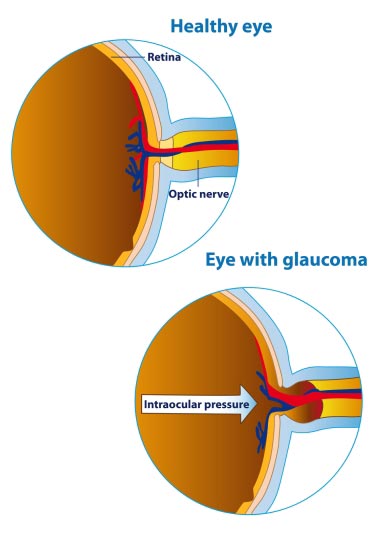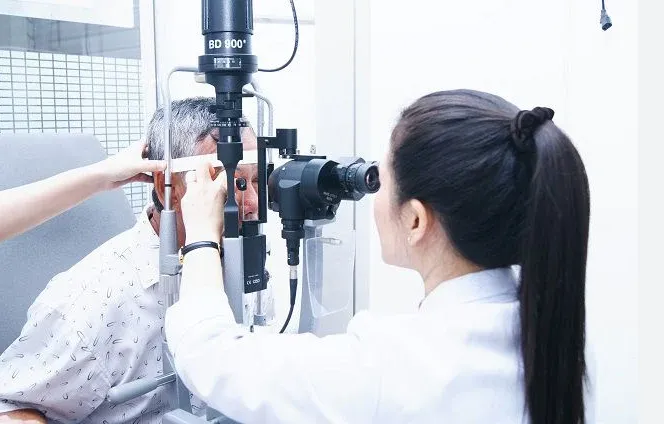Glaucoma can lead to permanent blindness if not detected early. Learn to recognize early symptoms, understand the risks, and explore modern treatment options.

Comparison Between a Healthy Eye and an Eye With Glaucoma Due to Elevated Intraocular Pressure
What Is Glaucoma?
Glaucoma, also known as the “silent thief of sight,” is a group of eye conditions that gradually damage the optic nerve—most often due to increased intraocular pressure. What makes glaucoma especially dangerous is its silent progression; most patients are unaware they have it until their vision has already been significantly impaired. Globally, glaucoma is the second leading cause of irreversible blindness, after cataracts.
Early Detection: Common Signs Often Overlooked

Halos Around Lights – An Early Warning Sign of Glaucoma
In its early stages, glaucoma symptoms are usually mild and easily mistaken for general eye fatigue. Many people describe slightly blurred vision at night, seeing halos around lights, or experiencing a dull ache around the forehead. Some may feel heaviness or eye strain after prolonged screen time or reading.
With careful attention, patients might also notice a gradual loss of peripheral (side) vision, making it harder to detect objects to the sides—especially when driving or walking in crowded areas.
Who Should Be Especially Cautious?
Not everyone has the same risk of developing glaucoma. People over 40 should undergo regular eye screenings. Additionally, if you have a family history of glaucoma, high myopia, diabetes, or hypertension, your risk is significantly higher.
Other risk factors include previous eye trauma, past eye surgeries, or prolonged use of corticosteroid eye drops.
Why Is Late Detection So Dangerous?
Glaucoma-related damage to the optic nerve is irreversible. Once vision is lost, no treatment can restore it. That’s why early detection is critical to preventing permanent blindness.
In cases of acute glaucoma, symptoms can appear suddenly and include severe eye pain, nausea, vomiting, and rapid vision loss. This is a medical emergency and requires immediate treatment.
Diagnosing Glaucoma: Simple with the Right Examination
Doctor Examines the Optic Nerve Through Fundoscopy in a Glaucoma Patient
Thanks to modern technology, diagnosing glaucoma today is both quick and accurate. During an eye exam, your doctor will measure intraocular pressure (IOP)—a key indicator of pressure inside the eye. This is combined with optic nerve evaluation using fundoscopy, OCT imaging to assess the nerve fiber layer structure, and visual field testing to detect peripheral vision loss.
These procedures are painless, fast, and completely safe. More importantly, they are highly effective in detecting glaucoma even before noticeable symptoms appear.
Modern Treatment: Preserving Long-Term Vision
Depending on the stage of the disease, your doctor will recommend the most appropriate treatment. In early stages, medicated eye drops to lower IOP are commonly prescribed. These drops are tailored to each patient and must be used consistently and on schedule for optimal results.
If medication alone is insufficient, laser treatments may be considered. For angle-closure glaucoma, laser iridotomy helps improve fluid drainage. For open-angle glaucoma, laser trabeculoplasty enhances outflow through the eye’s drainage system.
In advanced cases or when medications and laser treatments are no longer effective, surgery may be necessary. Depending on the condition, your doctor may perform a trabeculectomy (creating a new drainage pathway), implant a drainage valve, or insert devices like XEN or iStent to achieve long-term pressure control.
Expert Reminder

Slit-Lamp Examination Helps Detect Early Glaucoma Damage
Glaucoma cannot be completely cured, but it can be effectively managed if detected early and treated properly. Regular follow-up exams, strict adherence to your doctor’s instructions, and consistent monitoring of vision are the keys to preserving long-term eyesight.
Take Action Today
If you’re over 40, have a family history of glaucoma, or fall into a high-risk group—don’t wait. A simple eye exam could be the turning point in protecting your vision for life.
Healthy Eyes, Bright Future. Don’t Let Glaucoma Steal Your Sight.

 vi
vi 06-Jun-2025
06-Jun-2025











 0916.741.763
0916.741.763 Appointment
Appointment